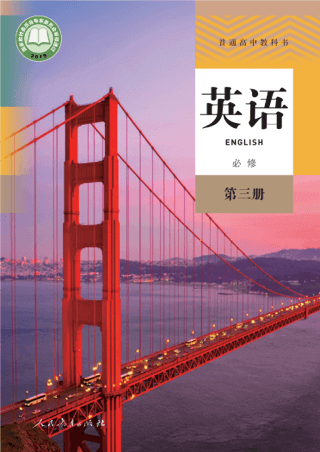英语人教版必修三课文目录
UNIT 3 DIVERSE CULTURES课文翻译及听力音频
UNIT 3 DIVERSE CULTURES 翻译:第 3 单元 多元文化
The beauty of the world lies in the diversity of its people. —Unknown 翻译:世界之美在于其人民的多样性。 ——佚名
Listening and Speaking 翻译:听力和口语
2 Listen to a radio interview about American food and check whether your answers to Activity 1 are correct. 翻译:2 听一段关于美国食物的电台采访,检查你对活动 1 的回答是否正确。
—Today, our guest is Steve Fox. He's here to talk about cultural influences on American food, welcome Steve. 翻译:——今天的客人是史蒂夫·福克斯。他在这里谈论文化对美国食物的影响,欢迎史蒂夫。
—Thank you. It's nice to be here. 翻译: ——谢谢,很高兴来到这里。
—When it comes to American food, some say no food was ever invented in America. What do you think? 翻译: ——说到美国食物,有人说美国从未发明过食物。你怎么认为?
—Uh, that's not really true. For example, some say the hamburger comes from Hamburg in Germany, but they're wrong, the recipes for the meat in a hamburger may have come from Germany, but the final hamburger we know today was definitely created by Americans. 翻译: ——呃,这不是真的。例如有人说汉堡包来自德国汉堡,但他们错了,汉堡中的肉的食谱可能来自德国,但我们今天所知道的最后一个汉堡肯定是由美国人创造的。
—You mean, there was a mixing of cultures. Food from overseas changed when it arrived in the States? 翻译: ——你的意思是,不同文化之间进行了融合。来自海外的食物到了美国后发生了变化?
—Right, and there are many more examples of mixed culture dishes, like nachos for example. 翻译: ——对,没错,还有很多融合文化的菜肴,例如玉米片之类的。
—Oh, I just love nachos. Mexican corn chips covered in cheese. 翻译: ——哦,我很喜欢玉米片。裹着奶酪的墨西哥玉米片。
—Yes, they're delicious. But they're not traditional Mexican food. The recipe was actually invented by a Mexican cook for his American customers, then there are fortune cookies. 翻译: ——是的,它们很好吃。但它们不是传统的墨西哥食物。这个食谱实际上是由一位墨西哥厨师为他的美国顾客发明的,然后就是幸运饼干了。
—What do you mean? 翻译: ——什么意思?
—They're not Chinese. 翻译: ——它们并不是中国的。
—You're kidding! But every Chinese restaurant in America has them. 翻译: ——你在开玩笑吧!但美国的每家中餐馆都有。
—Yes, but they're unknown in China. About one hundred years ago someone in San Francisco put a piece of paper with a fortune on it inside a Japanese style cookie, and the fortune cookie was born. 翻译: ——没错,但它们在中国并不为人所知。大约一百年前,旧金山有人把一张写着祝福语的纸条放进了一种日式饼干里,就这样幸运饼干诞生了。
—Wow, that's interesting. So they're like a mix of the Chinese, American and Japanese cultures? 翻译: ——哇,真有意思。所以它们就像是中美日文化的混合体咯?
—You got it. And then we have gumbo, the spicy stew. It was invented in new Orleans over two hundred years ago and mixes his French African native American and Spanish cooking. 翻译: ——没错。然后还有秋葵浓汤,这道辣味炖菜。是两百多年前在新奥尔良发明的,融合了法国、非洲、美洲原住民和西班牙的烹饪特色。
—So it's the food of many different cultures all in one dish? 翻译: ——所以这道菜融合了许多不同文化的特色?
—Exactly, American cooking often mixes things from around the world to make something completely new. 翻译: ——确切地说,美国烹饪经常将来自世界各地的食材混合在一起,做出全新的东西。
3 Listen to the interview again and decide whether the statements are true (T) or false (F). 翻译:3 再听一遍,判断陈述是真(T)还是假(F)。
—Today, our guest is Steve Fox. He's here to talk about cultural influences on American food, welcome Steve. 翻译:——今天的客人是史蒂夫·福克斯。他在这里谈论文化对美国食物的影响,欢迎史蒂夫。
—Thank you. It's nice to be here. 翻译: ——谢谢。很高兴来到这里。
—When it comes to American food, some say no food was ever invented in America. What do you think? 翻译: ——说到美国食物,有人说美国从未发明过食物。你怎么认为?
—Uh, that's not really true. For example, some say the hamburger comes from Hamburg in Germany, but they're wrong, the recipes for the meat in a hamburger may have come from Germany, but the final hamburger we know today was definitely created by Americans. 翻译: ——呃,这不是真的。例如有人说汉堡包来自德国汉堡,但他们错了,汉堡中的肉的食谱可能来自德国,但我们今天所知道的最后一个汉堡肯定是由美国人创造的。
—You mean, there was a mixing of cultures. Food from overseas changed when it arrived in the States? 翻译: ——你的意思是,不同文化之间进行了融合。来自海外的食物到了美国后发生了变化?
—Right, and there are many more examples of mixed culture dishes, like nachos for example. 翻译: ——对,没错,还有很多融合文化的菜肴,例如玉米片之类的。
—Oh, I just love nachos. Mexican corn chips covered in cheese. 翻译: ——哦,我很喜欢玉米片。裹着奶酪的墨西哥玉米片。
—Yes, they're delicious. But they're not traditional Mexican food. The recipe was actually invented by a Mexican cook for his American customers, then there are fortune cookies. 翻译: ——是的,它们很好吃。但它们不是传统的墨西哥食物。这个食谱实际上是由一位墨西哥厨师为他的美国顾客发明的,然后就是幸运饼干了。
—What do you mean? 翻译: ——什么意思?
—They're not Chinese. 翻译: ——它们并不是中国的。
—You're kidding! But every Chinese restaurant in America has them. 翻译: ——你在开玩笑吧!但美国的每家中餐馆都有。
—Yes, but they're unknown in China. About one hundred years ago someone in San Francisco put a piece of paper with a fortune on it inside a Japanese style cookie, and the fortune cookie was born. 翻译: ——没错,但它们在中国并不为人所知。大约一百年前,旧金山有人把一张写着祝福语的纸条放进了一种日式饼干里,就这样幸运饼干诞生了。
—Wow, that's interesting. So they're like a mix of the Chinese, American and Japanese cultures? 翻译: ——哇,真有意思。所以它们就像是中美日文化的混合体咯?
—You got it. And then we have gumbo, the spicy stew. It was invented in new Orleans over two hundred years ago and mixes his French African native American and Spanish cooking. 翻译: ——没错。然后还有秋葵浓汤,这道辣味炖菜。是两百多年前在新奥尔良发明的,融合了法国、非洲、美洲原住民和西班牙的烹饪特色。
—So it's the food of many different cultures all in one dish? 翻译: ——所以这道菜融合了许多不同文化的特色?
—Exactly, American cooking often mixes things from around the world to make something completely new. 翻译: ——确切地说,美国烹饪经常将来自世界各地的食材混合在一起,做出全新的东西。
4 Listen to the interview again and complete the notes below. 翻译:4 再听一遍,并完成以下笔记。
—Today, our guest is Steve Fox. He's here to talk about cultural influences on American food, welcome Steve. 翻译:——今天的客人是史蒂夫·福克斯。他在这里谈论文化对美国食物的影响,欢迎史蒂夫。
—Thank you. It's nice to be here. 翻译: ——谢谢。很高兴来到这里。
—When it comes to American food, some say no food was ever invented in America. What do you think? 翻译: ——说到美国食物,有人说美国从未发明过食物。你怎么认为?
—Uh, that's not really true. For example, some say the hamburger comes from Hamburg in Germany, but they're wrong, the recipes for the meat in a hamburger may have come from Germany, but the final hamburger we know today was definitely created by Americans. 翻译: ——呃,这不是真的,例如有人说汉堡包来自德国汉堡,但他们错了,汉堡中的肉的食谱可能来自德国,但我们今天所知道的最后一个汉堡肯定是由美国人创造的。
—You mean, there was a mixing of cultures. Food from overseas changed when it arrived in the States? 翻译: ——你的意思是,不同文化之间进行了融合。来自海外的食物到了美国后发生了变化?
—Right, and there are many more examples of mixed culture dishes, like nachos for example. 翻译: ——对,没错,还有很多融合文化的菜肴,例如玉米片之类的。
—Oh, I just love nachos. Mexican corn chips covered in cheese. 翻译: ——哦,我很喜欢玉米片。裹着奶酪的墨西哥玉米片。
—Yes, they're delicious. But they're not traditional Mexican food. The recipe was actually invented by a Mexican cook for his American customers, then there are fortune cookies. 翻译: ——是的,它们很好吃。但它们不是传统的墨西哥食物。这个食谱实际上是由一位墨西哥厨师为他的美国顾客发明的,然后就是幸运饼干了。
—What do you mean? 翻译: ——什么意思?
—They're not Chinese. 翻译: ——它们并不是中国的。
—You're kidding! But every Chinese restaurant in America has them. 翻译: ——你在开玩笑吧!但美国的每家中餐馆都有。
—Yes, but they're unknown in China. About one hundred years ago someone in San Francisco put a piece of paper with a fortune on it inside a Japanese style cookie, and the fortune cookie was born. 翻译: ——没错,但它们在中国并不为人所知。大约一百年前,旧金山有人把一张写着祝福语的纸条放进了一种日式饼干里,就这样幸运饼干诞生了。
—Wow, that's interesting. So they're like a mix of the Chinese, American and Japanese cultures? 翻译: ——哇,真有意思。所以它们就像是中美日文化的混合体咯?
—You got it. And then we have gumbo, the spicy stew. It was invented in new Orleans over two hundred years ago and mixes his French African native American and Spanish cooking. 翻译: ——没错。然后还有秋葵浓汤,这道辣味炖菜。是两百多年前在新奥尔良发明的,融合了法国、非洲、美洲原住民和西班牙的烹饪特色。
—So it's the food of many different cultures all in one dish? 翻译: ——所以这道菜融合了许多不同文化的特色?
—Exactly, American cooking often mixes things from around the world to make something completely new. 翻译: ——确切地说,美国烹饪经常将来自世界各地的食材混合在一起,做出全新的东西。
Pronunciation 翻译:发音
1 Listen to the passage about Native Americans. 翻译:1 听这段关于美洲原住民的文章。
Mark the pauses that you hear. The first sentence has been done for you. 翻译:标记你听到的停顿。第一句话已经为你完成了。
No one really knows exactly when the first people arrived in what we now know as California. 翻译:没有人确切知道第一批人是什么时候到达我们现在所知道的加利福尼亚州的。
It is likely that Native Americans moved to California at least fifteen thousand years ago. 翻译:美洲原住民很可能至少在一万五千年前搬到了加利福尼亚州。
Scientists believe that these settlers crossed the Bering Strait by a land bridge which existed in prehistoric times. 翻译:科学家们认为,这些定居者是通过史前时期存在的陆桥穿越白令海峡的。
In the 16th century, the native people suffered greatly after the arrival of the Europeans. 翻译:16 世纪,欧洲人到来后,当地人遭受了巨大的痛苦。
Thousands of them were killed or forced into slavery. 翻译:数千人被杀害或被迫成为奴隶。
In addition, many died from the diseases brought by the Europeans. 翻译:此外,许多人死于欧洲人带来的疾病。
However, some survived these terrible times, and today there are more Native Americans living in California than in any other state of America. 翻译:然而,一些人挺过了这段可怕的时期,今天居住在加利福尼亚州的美洲原住民比美国其他任何州都多。
2 Listen again and repeat. 翻译:2 再听一遍,重复一遍。
Reading and Thinking 翻译:阅读与思考
2 Scan Li Lan's travel journal and find out the places that she has been to or plans to visit. 翻译:2 浏览李岚的旅游日记,找出她去过或计划去的地方。
Wednesday, 21 June 翻译:6 月 21 日,星期三
Today was my first day back in San Francisco after camping in the Redwood Forest and visiting the wine country of Napa Valley. 翻译:今天是我从红木森林露营和参观纳帕谷葡萄酒产区后回到旧金山的第一天。
I have to admit that it definitely feels good to be back in the city again. 翻译:我得承认,再次回到城市确实感觉很好。
And what a city 翻译:而且是一座怎样的城市啊
—a city that was able to rebuild itself after the earthquake that occurred in 1906. 翻译:——一座在 1906 年地震后能够重建的城市。
There are so many beautiful old buildings—many sitting on top of big hills, offering great views of the city, the ocean, and the Golden Gate Bridge. 翻译:有那么多美丽的老建筑——许多坐落在大山上,提供了城市、大海和金门大桥的绝佳景色。
My hotel is near downtown, in the Mission District, 翻译:我的酒店位于市中心附近的传教区,
one of the oldest parts of the city. 翻译:这是城市最古老的区域之一。
Many of the people living here are from Mexico or Central America. 翻译:住在这里的许多人来自墨西哥或中美洲。
This district used to be a poor area of town, 翻译:这个地区过去是镇上较贫穷的地方,
but is now a centre for art, music, and food. 翻译:但现在已成为艺术、音乐和美食的中心。
In fact, an art movement called the 'Mission School' started here. 翻译:事实上,一个名为“传教学派”的艺术运动就是从这里开始的。
It's influenced by graffiti art and comic art. 翻译:它受到涂鸦艺术和漫画艺术的影响。
I walked around looking at the street art for a few hours. 翻译:我在周围走了几个小时,欣赏街头艺术。
It was quite modern and lively. 翻译:那里的艺术相当现代且充满活力。
Afterwards, I ate some delicious Mexican-Chinese noodles from a food truck. 翻译:之后,我从一辆食品卡车吃了一些美味的墨西哥中式面条。
A real mix of cultures here! 翻译:这里的文化真是多种多样!
In the afternoon, 翻译:下午,
I headed to a local museum that showed the historical changes in California. 翻译:我前往当地一家展示加州历史变迁的博物馆。
I learnt that America got California from Mexico in 1848. 翻译:我听说美国在 1848 年从墨西哥获得了加利福尼亚。
In the same year, gold was discovered near San Francisco, which started a gold rush. 翻译:同年,在旧金山附近发现了黄金,引发了淘金热。
Over 300,000 people came from all over the world to seek their fortune, and San Francisco quickly became a big city. 翻译:超过 30 万人从世界各地赶来寻找财富,旧金山迅速成为一个大城市。
Many Chinese arrived during this period. 翻译:许多中国人在这个时期来到这里。
To earn a living, some opened up shops and restaurants in Chinatown. 翻译:为了谋生,一些人在唐人街开了商店和餐馆。
Many others found jobs on farms, joined the gold rush, or went to build the railway that joined California to the eastern region of the country. 翻译:许多其他人在农场找到了工作,加入了淘金热,或者修建了连接加利福尼亚州和该国东部地区的铁路。
The museum did a really good job of showing how America was built by immigrants from different countries and cultures. 翻译:博物馆在展示美国是如何由来自不同国家和文化的移民建立起来的方面做得很好。
When these immigrants left their countries, they carried a bit of home in their hearts, and built a new home here. 翻译:当这些移民离开他们的国家时,他们心中带着一点家,在这里建立了一个新家。
This evening, I went to Chinatown. 翻译:今天晚上,我去了唐人街。
There were so many good cafes and restaurants to choose from. 翻译:有这么多好的咖啡馆和餐馆可供选择。
I selected a Cantonese restaurant that served its food on beautiful china plates. 翻译:我选择了一家粤菜餐厅,用漂亮的瓷盘盛放食物。
What great food! 翻译:多么美味的食物啊!
That's enough for today. 翻译:今天非常满足。
Tomorrow evening, I'm going to a jazz bar in the Richmond District. Can't wait! 翻译:明天晚上,我要去里士满区的一家爵士酒吧。我已经迫不及待了!
Listening and Talking 翻译:倾听和交谈
2 Justin met a new friend while travelling in Guizhou. 翻译:2 贾斯汀在贵州旅行时遇到了一个新朋友。
Listen to their conversation and complete the summaries below. 翻译:听他们的对话,并完成下面的总结。
Listening part 1: 翻译:听力第 1 部分:
—Hey, Ouye, do you know what kind of instrument these miao performers are playing? 翻译: ——嘿,欧叶,你知道这些苗族表演者正在演奏的是什么乐器吗?
—Yes, it's called lusheng, my favorite musical instrument. 翻译: ——知道呀,它叫芦笙,是我最喜欢的乐器。
—It sounds beautiful. Is it made of bamboo? 翻译: ——它的声音真好听。是竹子做的吗?
—Yes. Can you guess when it was invented? 翻译: ——对呀。你能猜出它是什么时候被发明的吗?
—Uh ... Five hundred years ago? I can't tell, I know China has a very long history. 翻译: ——呃⋯⋯五百年前?我可说不准,我知道中国历史很悠久。
—That's a good guess. But the lusheng actually has a history of over three thousand years. It's even mentioned in the oldest collection of Chinese poetry. 翻译: ——猜得不错哦。但实际上芦笙已经有三千多年的历史了。在中国最古老的诗歌总集里都有提到它。
—Wow, such a long time ago. There must be many beautiful songs. 翻译: ——哇,这么久之前就有了呀。那肯定有很多美妙的曲子吧。
—Yes, indeed, and they all make me proud. You know, I'm a Miao too and I'm really proud of our culture. Look, the performers are performing the lusheng dance. 翻译: ——确实是呀,这些都让我倍感自豪。你知道的,我也是苗族,我真的为我们的文化感到骄傲。看,表演者们正在表演芦笙舞。
—This is great, and I really like the silver accessories that the girls are wearing. What are they? 翻译: ——这太棒了,我特别喜欢那些姑娘们戴的银饰品。它们是什么呀?
—Oh, they're traditional handmade accessories. I can help you buy some as souvenirs if you like. 翻译: ——哦,它们是传统的手工饰品。如果你喜欢的话,我可以帮你买一些当作纪念品。
—Great, thanks. I hope they're not too expensive. 翻译: ——太好了,谢谢。我希望它们不会太贵。
—Oh, well, it'll depend on the percentage of silver. 翻译: ——哦,这个嘛,得看含银量的多少了。
Listening Part 2: A few minutes later. 翻译: 听力第 2 部分:几分钟后。
—Great. Now I have my souvenirs. So where are we going next, ouye? 翻译: ——太好了。现在我有纪念品了。那么欧叶,我们接下来要去哪儿呢?
—I'm taking you to Zhaoxing, a pretty Dong village. It's considered one of China's most beautiful villages. 翻译: ——我要带你去肇兴,一个很漂亮的侗族村寨,它被视作中国最美的村寨之一。
—Great. I can't wait. There must be a lot to see. 翻译: ——太棒了。我都等不及了。肯定有很多可看的景色。
—There is. First, I'll take you to see the beautiful drum towers and then the wind and rain bridges. The Dong play the lusheng, too. Perhaps you'll see them perform the grand song of the Dong people. Believe me, you'll love it. 翻译: ——没错。首先,我会带你去看那些漂亮的鼓楼,然后是风雨桥。侗族也演奏芦笙。或许你还能看到他们表演侗族大歌。相信我,你会喜欢的。
—Wow. I'm really looking forward to it now. 翻译: ——哇哦。我现在真的特别期待了。
Reading for Writing 翻译:阅读写作
1 Read the introduction to the Chinatown in San Francisco and answer the questions. 翻译:1 阅读旧金山唐人街的介绍并回答问题。
WELCOME TO CHINATOWN! 翻译:欢迎来到唐人街!
The Chinatown in San Francisco is the biggest in America, and also the oldest. 翻译:旧金山的唐人街是美国最大的,也是最古老的唐人街。
It is a very popular tourist draw that receives more visitors each year than even the Golden Gate Bridge. 翻译:它是一个非常受欢迎的旅游景点,每年接待的游客甚至比金门大桥还多。
The climate is mild all year round, meaning it is always a good time to visit. 翻译:气候全年温和,这意味着这总是一个参观的好时机。
Historically, Chinese immigrants settled in the area during the railroad construction and gold rush period. 翻译:历史上,中国移民在铁路建设和淘金热时期定居在该地区。
What started as a residential area for Chinese immigrants then turned into a centre for Chinese culture. 翻译:最初是中国移民的居住区,后来变成了中国文化的中心。
The majority of residents in Chinatown are still ethnic Chinese, many of whom do not speak English fluently. 翻译:唐人街的大多数居民仍然是华裔,其中许多人英语说得不流利。
This allows visitors to experience a real taste of China. 翻译:这让游客体验到真正的中国味道。
Most of Chinatown was destroyed in the 1906 earthquake, but the city and residents rebuilt it, taking care to include lots of Chinese architecture. 翻译:唐人街的大部分在 1906 年的地震中被摧毁,但这座城市和居民重建了它,并注意到其中包含了许多中国建筑。
Traditionally, visitors enter Chinatown through the legendary Dragon Gate, which was built using materials donated from China. 翻译:传统上,游客通过传说中的龙门进入唐人街,龙门是用中国捐赠的材料建造的。
Other famous sites include the Tin How Temple and Bank of Canton, to name but a few. 翻译:其他著名的景点包括天后宫和广东银行,仅举几例。
Visitors can also spend hours just exploring the interesting sights, smells, and sounds of China. 翻译:游客还可以花几个小时探索中国有趣的风景、气味和声音。
Portsmouth Square is also a key site, being the centre of Chinatown. 翻译:朴茨茅斯广场也是一个重要的景点,是唐人街的中心。
It has a long and famous history, with the author Robert Louis Stevenson having spent much time writing there. 翻译:它有着悠久而著名的历史,作家罗伯特·路易斯·史蒂文森在那里花了很多时间写作。
These days, the square is a great place to see traditional Chinese culture in real life, such as games of Chinese chess, and people practising tai chi. 翻译:如今,广场是一个在现实生活中看到中国传统文化的好地方,比如下棋和人们练习太极。
The stores in the Chinatown offer a unique range of souvenirs, goods, and clothing. 翻译:唐人街的商店提供各种独特的纪念品、商品和服装。
All kinds of traditional Chinese herbal medicine can be found, too, and there are Chinese tea stores, where visitors can taste and buy varieties of Chinese tea. 翻译:这里也有各种各样的中草药,还有中国茶店,游客可以在那里品尝和购买各种中国茶。
But perhaps what many tourists and San Franciscans treasure most about Chinatown is its food. 翻译:但也许许多游客和旧金山人最珍视唐人街的是它的食物。
There is Chinese food to suit everyone's taste, with traditional dishes from all over China. 翻译:有适合每个人口味的中国菜,有来自中国各地的传统菜肴。
Chinatowns are an important part of the diverse culture of the USA. 翻译:唐人街是美国多元文化的重要组成部分。
They allow visitors who have never been to China to experience traditional Chinese culture first hand. 翻译:它们让从未去过中国的游客能够亲身体验中国传统文化。
最新学习记录 更新时间:2025-12-16 09:04:45



 切换教材
切换教材